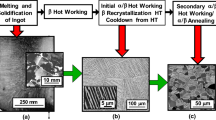Summary
Constitutive modeling for the particle size effect on the strength of particulate-reinforced metal matrix composites is investigated. The approach is based on a gradient-dependent theory of plasticity that incorporates strain gradients into the expression of the flow stress of matrix materials, and a finite unit cell technique that is used to calculate the overall flow properties of composites. It is shown that the strain gradient term introduces a spatial length scale in the constitutive equations for composites, and the dependence of the flow stress on the particle size/spacing can be obtained. Moreover, a nondimensional analysis along with the numerical result yields an explicit relation for the strain gradient coefficient in terms of particle size, strain, and yield stress. Typical results for aluminum matrix composites with ellipsoidal particles are calculated and compare well with data measured experimentally.
Similar content being viewed by others
References
Kamat, S. V., Hirth, J. P., Mehrabian, R.: Mechanical properties of particulate-reinforced aluminummatrix composites. Acta Metall. Mater.37, 2395–2402 (1991).
Kamat, S. V., Rollet, A. D., Hirth, J. P.: Plastic deformation in Al-alloy matrix-alumina particulate composites. Scripta Metal. Mater.25, 27–32 (1991).
Brown, L. M.: Precipitation and dispersion hardening. In: Strength of metals and alloys (Haasen, P., Gerold, V., Kostorz, G., eds.), pp. 1551–1571. New York: Pergamon Press 1980.
Ashby, M. F.: The deformation of plastically non-homogeneous alloys. In: Strengthening methods in crystals (Kelly, A., Nicholson, R. B. eds.), p. 184. Amsterdam: Elsevier 1980.
Rhee, M., Hirth, J. P., Zbib, H. M.: A superdislocation model for the strengthening of metal matrix composites and the initiation and propagation of shear bands. Acta Metall. Mater.42, 2645–2655 (1994).
Rhee, M., Hirth, J. P., Zbib, H. M.: On the bowed out tilt wall model of flow stress and size effects in metal matrix composites. Scripta Metall. Mater.31, 1321–1324 (1994).
Li, J., Weng, G. J.: Micromechanical determination of the viscoplastic behavior of a metal-matrix composite. In: Inelasticity and micromechanics of metal matrix composites (Voyiadjis, G. Z., Ju, J. W., eds.), pp. 213–227. Amsterdam: Elsevier 1994.
Ju, J. W., Tseng, K. H.: Effective elastoplastic behavior of two-phase metal matrix composites: micromechanics and computational algorithms. In: Inelasticity and micromechanics of metal matrix composites (Voyiadjis, G. Z., Ju, J. W., eds.), pp. 121–141. Amsterdam: Elsevier 1994.
Ponte Castaneda, P.:New variational principles in plasticity and their application to composite materials. J. Mech. Phys. Solids40, 1757–1788 (1992).
Lee, B. J., Mear, M. E.: Effective properties of power-law solids containing elliptical inhomogeneities: Part I: Rigid inclusions. Mech. Mater.13, 313–336 (1992).
Bao, G., Hutchinson, J. W., McMeeking, R. M.: Particle reinforcement of ductile matrices against plastic flow and creep. Acta Metall. Mater.39, 1871–1882 (1991).
Zbib, H. M., Zhu, H. T.: On the mechanics of plastic deformation in metal-matrix composites. In: Inelasticity and micromechanics of metal matrix composites (Voyiadjis, G. Z., Ju, J. W., eds.), pp. 97–118. Amsterdam: Elsevier 1994.
Eringen, A. C.: Linear theory of nonlocal elasticity and dispersion of plane waves. Int. J. Eng. Sci.10, 425–435 (1972).
Eringen, A. C.: On nonlocal continuum thermodynamics. In: Modern developments in thermodynamics (Gal-Or, B., ed.). New York: Wiley 1974.
Eringen, A. C.: On nonlocal plasticity. Int. J. Eng. Sci.19, 1461–1474 (1981).
Aifantis, E. C.: On the microstructural origin of certain inelastic models. J. Eng. Mat. Tech.106, 326–330 (1984).
Aifantis, E. C.: The physics of plastic deformation. Int. J. Plasticity3, 211–247 (1987).
Dillon, O. W., Jr., Kratochvil, J.: A strain gradient theory of plasticity. Int. J. Solids Struct.6, 1513–1533 (1970).
Zbib, H. M., Aifantis, E. C.: On the localization and postlocalization behavior of plastic deformation. Part I: On the initiation of shear bands. Res. Mech.23, 261–277 (1988).
Zbib, H. T., Aifantis, E. C.: A gradient-dependent theory of plasticity: application to metal and soil instabilities. Appl. Mech. Rev.42, 295–304 (1989).
Zhu, H. T., Zbib, H. M.: A macroscopic model for plastic flow in metal-matrix composites. Int. J. Plasticity,II, 471–499 (1995).
Zbib, H. M., Aifantis, E. C.: On the gradient-dependent theory of plasticity and shear banding. Acta Mech.92, 209–225 (1992).
Zbib, H. M.: Size effect and shear banding in viscoplasticity with kinematic hardening. In: Material instabilities: theory and applications (Batra, R. C., Zbib, H. M.,eds.), pp. 19–33. AMD-Vol. 183/MD-Vol. 50 New York: ASME 1994.
Aifantis, E. C.: On the role of gradients in the localization of deformation and facture. Int. J. Eng. Sci.30, 1279–1299 (1990).
Aifantis, E. C.: Spatio-temporal instabilities in deformation and fracture. In: Computational material modeling (Noer, A., Needleman A., eds.), AD-Vol. 42/PVP-Vol. 294. New York: ASME 1994.
Muhlhaus, H. B., Aifantis, E. C.: A variational principle for gradient plasticity. Int. J. Solids Struct.28, 845–857 (1991).
Vardoulakis, I., Aifantis, E. C.: A gradient flow theory of plasticity for granular materials. Acta Mech.87, 197–217 (1991).
Zhu, H. T., Zbib, H. M., Khraisheh, M. K.: Flow strength and size effect of an Al−Si−Mg composite model system under multiaxial loadings. Scripta Metall. Mater.II, 1895–1902 (1995).
Aikin, R. M., Christodoulou, L.: The role of equiaxed particles on the yield stress of composites. Scripta Metall. Mater.25, 9–14 (1991).
Zhu, H. T., Zbib, H. M., Aifantis, E. C.: Flow strength and size effect in metal matrix composites. In: Micromechanics and constitutive modelling of composite materials (Zbib, H. M. et al., eds.), AMD-Vol. 202/MD-Vol. 61. New York: ASME (1995).
Ning, J., Aifantis, E. C.: Strain gradients and size effects in composites. In: Micromechanics and constitutive modelling of composite materials (Zbib, H. M. et al., eds.), AMD-Vol. 202/MD-Vol. 61. New York: ASME (1995).
Aifantis, E. C.: Higher order gradients and size effects. In: Size-scale effects in the failure mechanics of materials and structures, (Carbinteri, A., ed.), pp. 231–242. New York: Chapman and Hall 1995.
Aifantis, E. C.: Pattern formation in plasticity. Int. J. Eng. Sci.33, 2161–2178 (1995).
Author information
Authors and Affiliations
Rights and permissions
About this article
Cite this article
Zhu, H.T., Zbib, H.M. & Aifantis, E.C. Strain gradients and continuum modeling of size effect in metal matrix composites. Acta Mechanica 121, 165–176 (1997). https://doi.org/10.1007/BF01262530
Received:
Revised:
Issue Date:
DOI: https://doi.org/10.1007/BF01262530




